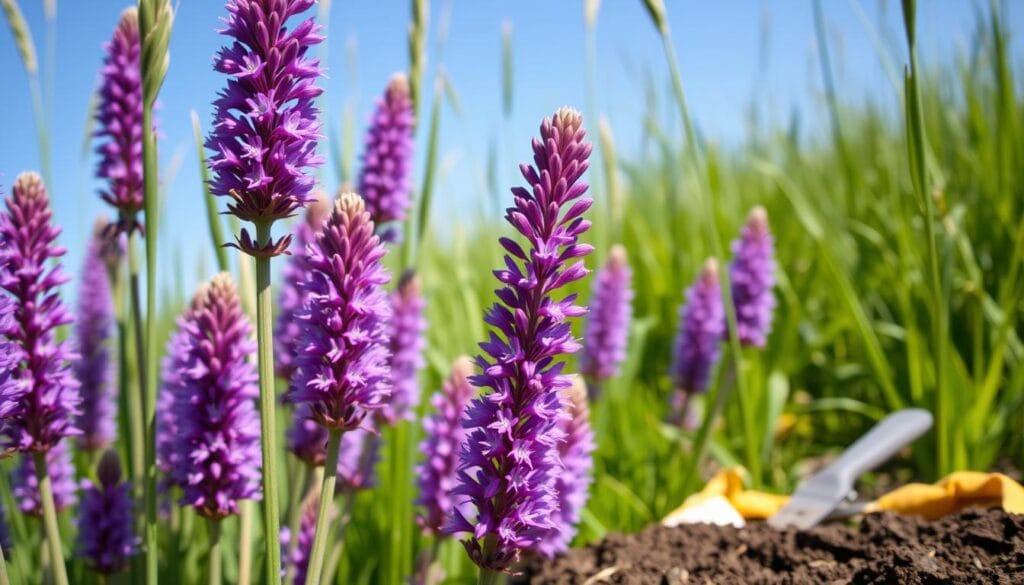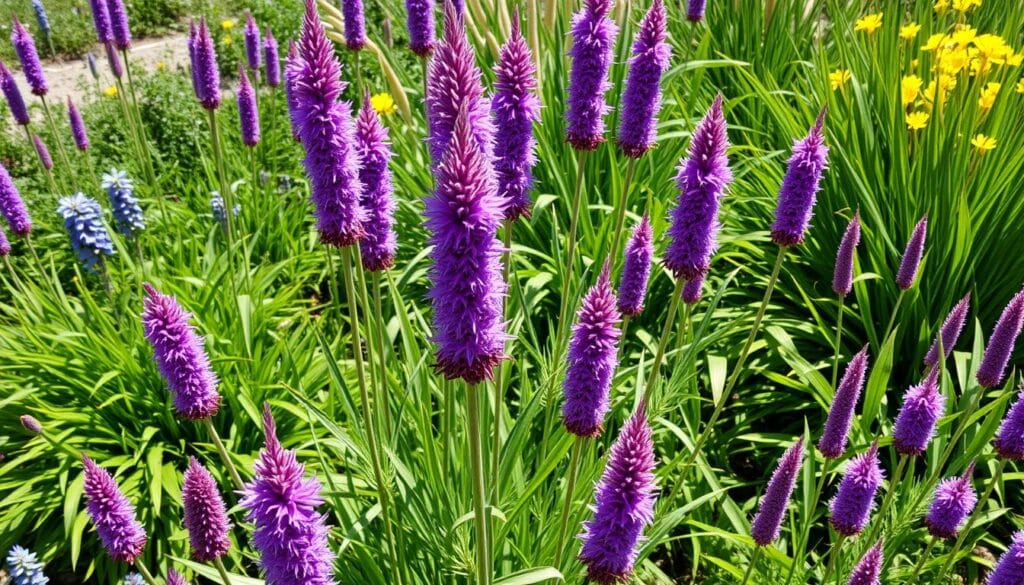Did you know the blazing star, or Liatris spicata, blooms for 70 to 90 days after planting1? This stunning perennial is also known as prairie blazing star, gayfeather, or button snakeroot. It’s a true showstopper in any garden. Native to Eastern North America, it brings wild prairie beauty to gardens.
I’m always amazed by this plant’s versatility. It thrives in USDA hardiness zones 3 to 9 and tolerates soil pH levels from 4.7 to 7.82. This makes it a great choice for gardeners across the United States.
The blazing star’s tall spikes of vibrant purple or white flowers create a dramatic vertical accent in gardens. These eye-catching blooms appear from mid to late summer, adding color when many other plants are past their prime1. It can grow 2 to 5 feet tall, with a spread of 9 to 18 inches, making it a substantial presence in any garden design3.
One of the things I love most about Liatris spicata is its low-maintenance nature. It’s drought-tolerant once established and rarely troubled by pests or diseases1. This hardy plant is not just a pretty face – it’s also a magnet for pollinators, making it an valuable addition to any wildlife-friendly garden.
Key Takeaways
- Liatris spicata blooms for 70-90 days after planting
- Adaptable to USDA zones 3-9 and various soil pH levels
- Grows 2-5 feet tall with purple or white flower spikes
- Low-maintenance and drought-tolerant once established
- Attracts pollinators and supports wildlife
- Ideal for prairie-style, cottage, and naturalistic gardens
Introduction to Blazing Star (Liatris spicata)
Blazing star, also known as dense blazing star or marsh blazing star, is a stunning perennial native to Eastern North America. It’s a prairie beauty with fascinating characteristics.
Native Origins and Characteristics
Liatris spicata thrives in prairies and meadows. It’s adaptable to different moisture levels. It loves wet to medium soil moisture4.
The plant’s grass-like leaves can grow up to 10 inches long at the base. They get smaller as they go up the stem4. Mature plants are 3 to 6 feet tall and 3 inches to one-and-a-half feet wide5.
Ornamental Appeal in Gardens
What makes blazing star special is its vibrant purple flowers. These wands of flowers bloom for about three weeks in mid to late summer4. Each flower head has four to ten disk flowers, with reddish or green bracts5.
This unique structure adds a striking vertical accent to any garden design.
Ecological Importance
Blazing star is vital for local ecosystems. It attracts bees, songbirds, butterflies, moths, and skippers5. The plant self-seeds and develops offsets through underground corms, ensuring its presence in natural landscapes5.
With a conservation value (C-value) of 7, marsh blazing star is an important native species5.
Whether you call it prairie plume or blazing star, it’s a valuable addition to any garden or restoration project.
Cultivation and Growing Conditions
Growing blazing star in your garden can be rewarding. I’ll share tips on cultivating this stunning perennial. This includes soil preferences, sunlight needs, and hardiness zones.
Ideal Soil and Sunlight Requirements
Liatris spicata loves full sun or light shade, making it versatile for gardens67. It prefers well-drained soil with lean to medium fertility. Plant them 12-15 inches apart for growth7.
Watering and Drainage Needs
Blazing star is drought-tolerant once established but needs good drainage to avoid root rot7. Feathery, slender, and rough blazing stars need consistent moisture in their first year. They become resilient after that.
https://www.youtube.com/watch?v=vRWNoVxdoBE
USDA Hardiness Zones
Liatris spicata is hardy and adapts to many climates in the United States. It grows well in USDA hardiness zones 3 to 9, with some up to zone 1067. This makes blazing star great for gardens in both cold northern states and warmer southern areas.
| Liatris Species | Height Range | Bloom Time |
|---|---|---|
| Liatris spicata | 2-5 feet | Mid-summer to autumn |
| Liatris pycnostachya | 2-5 feet | Late summer |
| Liatris aspera | 1-3 feet | Late summer to fall |
With proper care, these vibrant purple or white flowers can grow up to five feet tall. They add stunning vertical accents to any garden6. Plants grown from tubers bloom in the first year. Those from bulbils might take two years6.
Propagation Methods for Blazing Star
I love growing Liatris spicata in my garden. There are two main ways to do this: corm division and growing from seeds. Each method has its own benefits, and I’ll share my experiences with you.
Corm division is my favorite way to grow more Liatris. In early spring or fall, I dig around the clumps and gently lift the root mass. Then, I cut it into sections, making sure each has roots and growing buds.
I plant these new divisions at the same depth as before. This usually means about 5 inches deep for tuberous roots and 2-3 inches for bulbils. This method is great because the plants multiply and naturalize over time, creating a stunning display8.
Growing Liatris spicata from seeds is another option I enjoy. I collect seeds in fall and either direct sow them or cold-stratify for 12 weeks before planting. When planting, I make sure to sow them no deeper than ¼ inch for successful germination9.
It’s important to note that plants started from seed will bloom in their second year of maturity. The wait is worth it, though, as I get to see a variety of flower colors, from white to light pink8.
| Propagation Method | Best Time | Depth | Blooming Time |
|---|---|---|---|
| Corm Division | Early Spring or Fall | 5 inches (tuberous roots) 2-3 inches (bulbils) | First Year |
| Seeds | Fall or After Stratification | ¼ inch | Second Year |
Whichever method I choose, I’m always amazed by the resilience of Liatris spicata. These plants are drought and heat-tolerant, making them perfect for my garden8. Plus, they attract bees, butterflies, and birds, adding life to my outdoor space8. With a little patience and care, I can enjoy these vibrant prairie blooms year after year.
Planting and Care Instructions
I’m excited to share my tips for Liatris spicata planting and blazing star care. These vibrant prairie blooms are a joy to grow and maintain in your garden.
When and How to Plant
Spring is the best time to plant Liatris spicata. I plant corms in well-draining soil, making sure they get full sun for the best growth1011. Blazing star does well in poor soil but doesn’t like wet conditions, so drainage is key10.
Spacing and Depth Guidelines
I space my blazing stars 6 to 12 inches apart, giving them room to grow up to 4 feet tall11. When planting, I dig holes twice as wide as the root ball and a bit deeper. This helps with air circulation, preventing leaf spot and powdery mildew10.

Ongoing Maintenance Tips
Blazing star care is easy. I water new plants weekly during dry spells12. Once they’re established, they can handle drought and need little water10. I only fertilize if the soil is very poor, applying fertilizer in spring10.
These hardy plants bloom in mid to late summer, drawing in butterflies and other pollinators1112. With the right care, you’ll see amethyst-purple, pink, or white flowers about 70 to 90 days after planting12. Plus, Liatris spicata is deer-resistant, making it a great choice for many gardens1012.
Popular Cultivars and Varieties
I love the variety of Liatris spicata cultivars and blazing star varieties for gardens. There are about 32 species of Liatris across North America. This offers a wide range of options for plant lovers137.
‘Floristan Violet’ is a favorite of mine. It can grow up to 4 feet tall with its amethyst-colored plumes13. For smaller spaces, ‘Kobold’ is great. It’s 18 to 30 inches tall and has deep purple flowers, perfect for the front of a garden137.
‘Alba’ is a refreshing white option, growing 2 to 4 feet tall13. Eden Brothers offers a mix of purple and white prairie gayfeather. This adds color and interest to any garden14.
Other notable Liatris spicata cultivars include:
- Liatris aspera (Rough Blazing Star): Grows 2-3 feet tall and is loved by beneficial insects13.
- Liatris pycnostachya (Prairie Blazing Star): Can reach impressive heights of up to 5 feet13.
- Liatris microcephala (Appalachian Blazing Star): A compact variety, growing 1-2 feet tall13.
These blazing star varieties are not only beautiful but also attract pollinators. The Prairie Blazing Star, with its rosy-purple blooms, is a favorite of butterflies and pollinators13. Plant them in full sun with well-drained soil, spaced 12-15 inches apart. This will ensure healthy growth and vibrant blooms7.
Blazing Star (Liatris spicata) in Landscape Design
Liatris spicata, or blazing star, is a versatile plant that adds beauty to gardens. Its purple spikes bring vertical interest and vibrant color. It’s a favorite for adding life to landscapes.
Companion Planting Suggestions
I pair blazing star with sun-loving perennials like coneflowers and black-eyed Susans. Ornamental grasses also complement its upright form. Together, they create a natural look that’s easy to care for and beautiful.

Use in Various Garden Styles
Blazing star fits well in many garden styles. In cottage gardens, it adds a whimsical touch. For modern landscapes, it makes a bold statement when planted in mass.
It thrives in full sun and well-drained soils, perfect for rock gardens or xeriscapes15. It also attracts pollinators like bees, butterflies, and hummingbirds16.
Cut Flower Potentials
Blazing star is great for cut flower arrangements. Its blooms can reach up to five feet tall, lasting long in bouquets15. I often plant extra in my cutting garden for a steady supply.
When planting blazing star, space them 12 to 15 inches apart for best growth15. This spacing helps with air circulation and shows off the plant’s natural beauty. Liatris spicata is a true standout in any garden.
Wildlife Benefits of Liatris spicata
I’ve found that Liatris spicata, also known as Blazing Star, is great for wildlife. It blooms from mid-summer to early fall. This is when many other flowers stop blooming17.
Many pollinators love the purple spikes of Blazing Star. They attract butterflies, bees, and other helpful insects17. I’ve seen honeybees, bumblebees, long-horned bees, and leaf-cutting bees all enjoying the nectar17.
Butterflies and bees aren’t the only ones who benefit. American Goldfinches also love Blazing Star. They use it for food and to build their nests17. This plant is very important for supporting life in late summer when food is hard to find17.
| Wildlife Type | Benefit from Liatris spicata |
|---|---|
| Butterflies | Nectar source |
| Bees | Pollen and nectar |
| American Goldfinch | Food and nesting material |
| Other Beneficial Insects | Habitat and food source |
Liatris spicata is very good for our ecosystems. It helps keep pollinators healthy, which is key for our gardens and natural areas17. It’s a great choice for anyone wanting to help wildlife in their garden.
Common Pests and Diseases
Liatris spicata is generally hardy, but it’s not immune to problems. As a gardener, I’ve learned to stay vigilant to catch issues early. Let’s look at some common pests and how to handle them.
Identifying Issues
Spider mites leave webbing and speckled leaves. Scale insects look like bumps on stems and leaves. White fluffy deposits on leaves might mean mealybugs.
Aphids, whiteflies, leaf weevils, and caterpillars are less common but can damage plants18. Liatris Spicata blooms from July to August, showing off pink to purple flowers for 3-4 weeks19.
Prevention and Treatment Strategies
Prevention is key in managing problems. Regular checks and cleanliness help a lot. Early action is important.
IPM uses cultural practices, beneficial insects, and habitat changes. It also uses targeted chemicals when needed18.
Liatris Spicata loves full sun and moist, well-drained soil. Adding organic matter to the soil helps plant health. This makes plants more resistant to pests and diseases19.
By giving plants the best growing conditions, we can reduce pest risks. This ensures our plants stay vibrant and healthy.
Conclusion
I’ve learned how valuable Blazing Star (Liatris spicata) is in gardening. It brings many benefits, like its bright flowers and support for nature. It’s easy to grow and works well in many settings, great for both new and seasoned gardeners20.
Blazing Star is also easy to care for. It needs water when it’s dry and a little pruning to keep blooming. It attracts bees, butterflies, and hummingbirds, making it a standout in any garden20.
Liatris spicata is key to supporting biodiversity. It’s not just a pretty plant; it’s essential for our ecosystems. Dense Blazing Star, a relative, is threatened in Canada, showing how important these plants are21. By adding Blazing Star to our gardens, we help protect and support our local ecosystems.
My experience with Liatris spicata gardening has shown its design versatility. It looks great with plants like Coneflowers and Black-eyed Susans, creating lively beds. It’s perfect for a prairie garden, a pollinator garden, or adding height to your landscape. Its benefits go beyond the garden, useful in flower arrangements and traditional medicine20. Blazing Star is more than a beautiful flower; it’s a valuable asset to any garden and a friend to our environment.
FAQ
What are the key characteristics of Liatris spicata?
What are the ideal growing conditions for Liatris spicata?
How can I propagate Liatris spicata?
What are some tips for planting and caring for Liatris spicata?
What are some popular Liatris spicata cultivars?
How can I use Liatris spicata in landscape design?
Does Liatris spicata attract wildlife?
What are some common pests and diseases affecting Liatris spicata?
Source Links
- Liatris – How to Grow and Care for Blazing Star – Garden Design
- Blazing Star (Liatris spicata)
- How to Grow and Care for Blazing Star Liatris
- Liatris spicata
- Marsh blazing star | The Morton Arboretum
- How to Plant and Grow Blazing Star Flowers (Liatris Spicata)
- <em>Liatris</em>
- Growing Liatris Spicata: A Hardy Perennial With 4-Season Interest
- Propagating Dense Blazing Star: The Ultimate Guide
- Grow Tall Wands of Blazing Star Blooms in Pollinator Gardens
- How to Plant, Grow and Care For Blazing Star Flowers
- All About Liatris
- 9 Varieties of Blazing Star for Your Native Garden
- Liatris spicata/Blazing Star Corms | Shop %count% Varieties | Eden Brothers
- Liatris – Gardening Solutions
- Blazing Star (Liatris spicata)
- Liatris Spicata – Blazing Star – Bumbees
- What Are The Bugs on My Dense Blazing Star? 🐛
- | Growit Buildit
- Enhancing Your Landscape with Blazing Star
- January 2017 Biodiversity Spotlight | iDigBio


